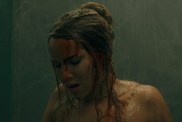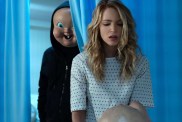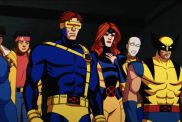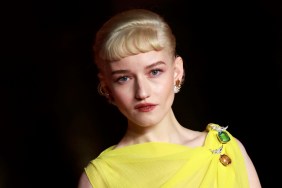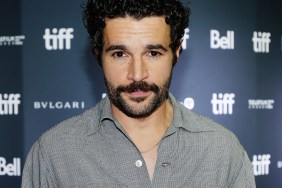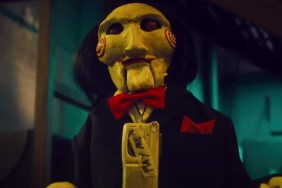
The Insidious movies are our spookiest contemporary horror series. While other films have been of the profoundly scary and devastating sort (Kill List), or loaded with anticipatory dread (It Follows), the Insidious films truly nail a jolting funhouse vibethe shadowy fun in being scared. Insidious: Chapter 3 holds strong here, which is refreshing in a time when the once hair-raising Night #1 title cards of the Paranormal Activities have long since lost their luster.
Its even more impressive when one considers the flat truth of constructing such nightmarish sequences. Insidious writer and now Insidious: Chapter 3 director Leigh Whannell is on the phone with Shock to talk contributing these terrifying bits to contemporary horror and laughing. You have to remember, when youre on a film set, its a sterile place and its a busy place, he says. Dozens of people standing around, holding equipment, checking their phones, yawning. Someones standing there eating a snickers bar, just off camera.
Every scary movie youve ever seen, or cinematic masterpiece The Godfather, 2001, The Shining. Just look at any frame of The Shining and pause it, and then picture yourself three feet past the edge of that frame, theres some dude eating a Snickers bar. That goes for Police Academy and that goes for 2001. Its not a very scary place.
Whannell talks of the virtues of music and editing, when a scene really starts to take shape, but what he and collaborator James Wan have also nailed are core ideas in their frights, and inventive setups evocative of simple anxieties: Is something on the other side of my sheet? Whose footsteps are those?
As Insidious: Chapter 3 hits theaters, I chose the five most frightening moments in the series and Whannell added smart, funny commentary on their ideas and production
Minor spoilers follow for this weekend’s Chapter 3
Scariest Insidious Moments
-
Scariest Insidious Moments #1

Insidious - Someone Pacing Outside the Window
Whannell: That actually came from a real life story. It started with a friend of mine, who shall remain nameless. He was the bass player in a really bad metal band. He’s a Japanese guy, a very friendly guy. He told me once that he used to see ghosts, kind of spooked me out. He was lying in bed one night, and he looked up and saw someone outside his window. He had a mattress on the floor, rather than being in a raised bed. When he looked up, he was staring up at this ground floor window and there was somebody outside the window pacing back and forth. If I remember correctly, he actually said they were smoking and pacing. He told me that he shut his eyes. He knew it was a ghost, so he shut his eyes and then when he opened them again, the guy was in the room, pacing at the end of his bed.
I thought that story was horrifying and I told it to James. He was like, “Dude, that’s a scene.” We always kept it in our back pocket. Full credit to my man Yoshi for that story. When I was writing Insidious, I knew I had to pull it out. I wrote the scene based on that.
-
Scariest Insidious Moments #2

Insidious - That Horrible Dancing Boy
Whannell: I remember thinking, "if I was walking through the house during the day and I saw that, that would be scary." Oftentimes, you’re trying to scare yourself. That’s the big thing you’re trying to do. That’s the only barometer you have. If I was walking through the house in the middle of the day, what would be the scariest possible thing?
There’s something about people facing away from you that is terrifying. Plenty of films have played on it. There’s that great final shot in The Blair Witch Project. If you can’t see somebody’s face, you don’t know their intentions. You don’t know what the expression on their face is. It’s very absent.
I was thinking this little boy was facing away from Rose Byrne, you never got to see his face. That is just an image that gives me chills, so I have to hope it gives someone else chills.
-
Scariest Insidious Moments #3

Insidious: Chapter 2 - All Around You
Whannell: You’re always trying to think of whatever the most oppressive thing could possibly be. Everybody’s done that pull the sheet over their head and imagine something’s there. I try to think, "what’s the worst possible result?"
You have time when you write a film. Hopefully you’re working with good people who treat writers with respect. You have a lot of time, you have maybe a month or two months, three months, to stare at the wall and think. Always with a notepad, never the laptop. I just sit there, and I might write ten bad versions before I come across the one that I like. For that film, my notepad might have said, “He pulls back the sheet and there’s someone popping over him.” I’d cross that out and write, “He pulls back the sheet and there’s nobody there.” I cross that out and I go to ten, fifteen, twenty versions before finally, I’m like, “He pulls back the sheet and there’s twenty people, all crowded very close to him.”
That’s really the process of writing these films, just time. Anyone who’s writing a horror film should not rush these things. You need to sit there. You need to be willing to stare at the wall for a week, you just got to let the ideas come.
-
Scariest Insidious Moments #4

Insidious: Chapter 3 - Vicious Car Accident
Whannell: Here, playing with sound is great, it’s one of the fun things about making a horror film. The narrative of the sound should tell a story. I like being experimental with it. Sound in cinema is one of my favorite things to explore, to investigate and to apply. Now that I’ve directed a film, I had so much fun at the soundstage. It’s so often forgotten about, because it’s invisible. Everybody talks about how great a film looks, what a great DP. Sound is harder to appreciate.
If it’s really good, it’s subliminal, but also if you focus on the sound, it takes you out of the movie. You can focus on the visual and still be in the movie. I just had a really good time with our mixers. We had Craig Mann and Martyn Zub. Craig actually won an Oscar for Whiplash right when he was mixing this film. That felt good, to have an Oscar winner at the desk. Those are all the little moments that we played with. We really experimented with it.
-
Scariest Insidious Moments #5

Insidious: Chapter 3 - Elise Follows Footprints
Whannell: There’s something about footprints, because you know there’s someone at the end of them. So, I love that idea and it was pretty much shot exactly as I wrote it. That’s one of the scenes that came off exactly.
There was a couple of stunt elements that were difficult to rig, but when I watch it, I’m like ‘Wow, that’s exactly the scene I saw.’ You come in and you do the sound, everything matters. I really waned that scene to be quiet. I think the quieter the scare scene, the more daring it is. Smothering a scare scene with music, even if it’s low in the mix and it’s like duh-nuh. You. Should. Be. Scared. Right. Now. It lets the audience off the hook. Silence makes them nervous. I just really loved putting that scene together. It’s possibly my favorite in the film, as well.
